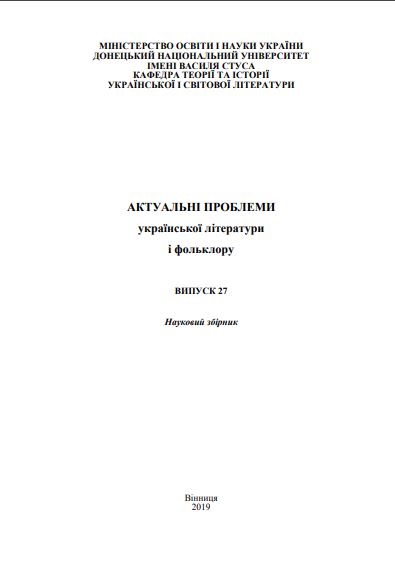Transformation of M. Khvylovy`s works by by means of cinema: semiotic aspect.
DOI:
https://doi.org/10.31558/2308-1902.2019.27.4Keywords:
semiotics, transcoding, cinematic sign, word sign, movie receptionsAbstract
The system of movie signs is examined, with the help of which the M. Khvylovy`s works are transferred to the screen. Various approaches to the semiotics of cinema have been analyzed, including Y. Lotman, Y. Tinyanov, S. Eisenstein, Z. Havrak, R. Bart, and a key classification of R. Havrak (visual, audio, associative, verbal and symbolic) has been selected. After all, that is the basis of the study.
It has been found that cinema allows to sharpen the «text» created by the writer with the help of the word, but sometimes because of the inability to accurately reproduce the visual, compositional, stylistic elements of cinematographers use «screen» equivalents, which allow to visual and audio purely literary moments. Thus, when adapting a literary "text" to the conditions of a cinematic environment, both common characters for literature and cinema, as well as specific «screen» characters are used. In the semiotics of cinema, the following characters are distinguished: sounds, soundtrack, monologues / dialogues / polylogues, various visual images, foreshortening, color play, light organization, camera movement, plans, etc.
An analysis of O. Muratov’s films showed that visual signs (interiors, landscapes, costumes, makeup, color combinations, objects that indicate the events) were used during the cinematic reception of stories and classic novels; audio (sound and noise effects, music, reverb, etc.); symbolic (emphasis is placed on certain objects-symbols that express the motive of the works: mask, window, dog, black smoke, revolver, etc.); linguistic (nonverbal – facial expressions, gestures, intonation, timbre – and verbal elements). It is determined that the tapes are "built" on such key cinematic techniques as refrain, associative communication, use of different editing techniques, change of plans (large, very large, medium, far), different light effects (sepia, diffused light). Thus, films have a number of coding chains that form characters that are perceived by the recipient, get the meaning embedded in the tapes, and are often unwittingly compared to literary correspondences.
References
Эйзенштейн С. Монтаж. Москва: ВГИК, 1998. 193 с.
Тишунина Н. Методология интермедиального анализа в свете междисциплинарных исследований. Методология гуманитарного знания в перспективе XXI века: материалы международной научной конференции. Серия «Symposium». СанктПетербург: Санкт-Петербургское философское общество, 2001. Вып. 12. С. 149–154.
Лотман Ю. Семиотика кино и проблемы киноэстетики. Таллин: Ээсти Раамат, 1973. 92 с.
Гаврак З. З французької семіотики кіно. Кіно-Театр. 2005. № 1. С. 24–29.
Барт Р. Избранные работы: Семиотика: Поэтика: Пер. с фр. Сост., общ. ред. и вступ. ст. Г. К. Косикова. Москва: Прогресс, 1989. 616 с.
Просалова В. Літературна й кінематографічна версії роману М. Хвильового «Вальдшнепи»: конфлікт конкретизацій. Актуальні проблеми української літератури і фольклору. 2017. Вип. 25. С. 93–107.
Wolf W. Musicalization of Fiction: A Study in the Theory and History of Intermediality. Amsterdam: Rodopy, 1999. 272 p.
Vanoye F. Récit écrit, récit filmique. Cinéma et récit-I. P.: Nathan, 1989. 218 р.
Epstein J. Le Cinématographe vu de l'Etna. 1926. 79 p.

